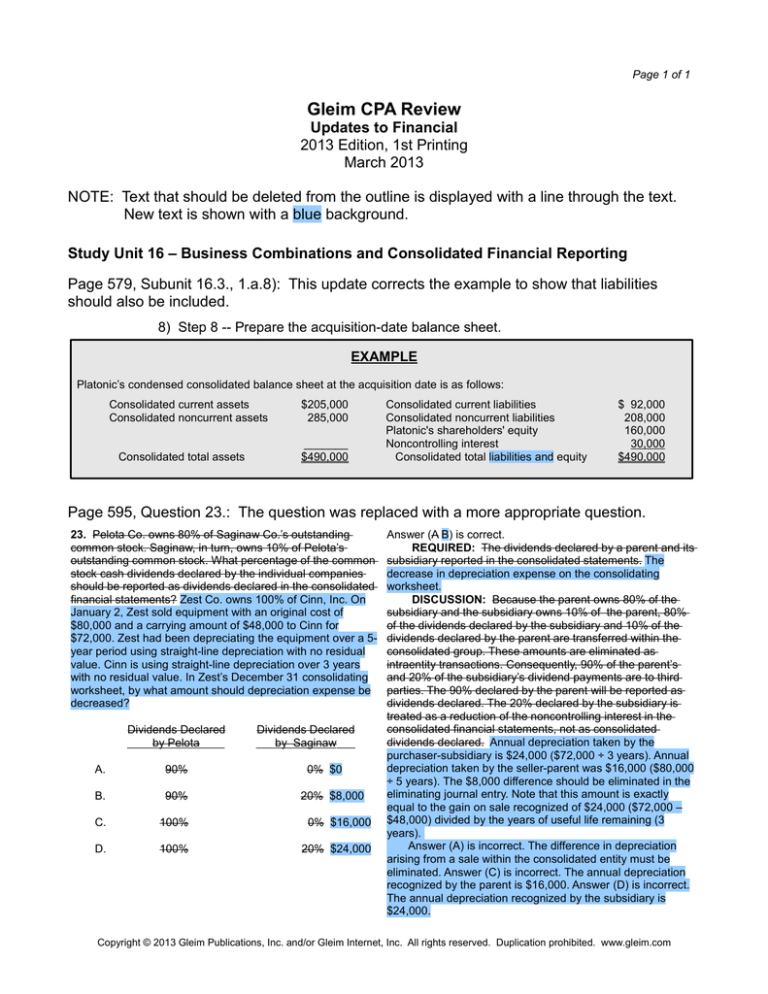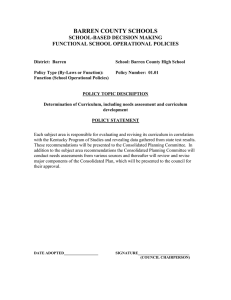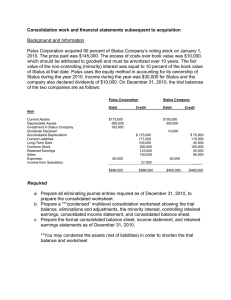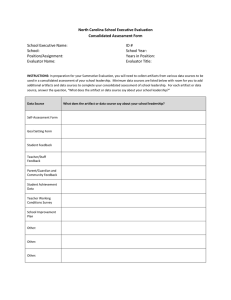
Page 1 of 1
Gleim CPA Review
Updates to Financial
2013 Edition, 1st Printing
March 2013
NOTE: Text that should be deleted from the outline is displayed with a line through the text.
New text is shown with a blue background.
Study Unit 16 – Business Combinations and Consolidated Financial Reporting
Page 579, Subunit 16.3., 1.a.8): This update corrects the example to show that liabilities
should also be included.
8) Step 8 -- Prepare the acquisition-date balance sheet.
EXAMPLE
Platonic’s condensed consolidated balance sheet at the acquisition date is as follows:
Consolidated current assets
Consolidated noncurrent assets
Consolidated total assets
$205,000
285,000
_______
$490,000
Consolidated current liabilities
Consolidated noncurrent liabilities
Platonic's shareholders' equity
Noncontrolling interest
Consolidated total liabilities and equity
$ 92,000
208,000
160,000
30,000
$490,000
Page 595, Question 23.: The question was replaced with a more appropriate question.
23. Pelota Co. owns 80% of Saginaw Co.’s outstanding
common stock. Saginaw, in turn, owns 10% of Pelota’s
outstanding common stock. What percentage of the common
stock cash dividends declared by the individual companies
should be reported as dividends declared in the consolidated
financial statements? Zest Co. owns 100% of Cinn, Inc. On
January 2, Zest sold equipment with an original cost of
$80,000 and a carrying amount of $48,000 to Cinn for
$72,000. Zest had been depreciating the equipment over a 5year period using straight-line depreciation with no residual
value. Cinn is using straight-line depreciation over 3 years
with no residual value. In Zest’s December 31 consolidating
worksheet, by what amount should depreciation expense be
decreased?
Dividends Declared
by Pelota
Dividends Declared
by Saginaw
A.
90%
0% $0
B.
90%
C.
100%
0% $16,000
D.
100%
20% $24,000
20% $8,000
Answer (A B) is correct.
REQUIRED: The dividends declared by a parent and its
subsidiary reported in the consolidated statements. The
decrease in depreciation expense on the consolidating
worksheet.
DISCUSSION: Because the parent owns 80% of the
subsidiary and the subsidiary owns 10% of the parent, 80%
of the dividends declared by the subsidiary and 10% of the
dividends declared by the parent are transferred within the
consolidated group. These amounts are eliminated as
intraentity transactions. Consequently, 90% of the parent’s
and 20% of the subsidiary’s dividend payments are to third
parties. The 90% declared by the parent will be reported as
dividends declared. The 20% declared by the subsidiary is
treated as a reduction of the noncontrolling interest in the
consolidated financial statements, not as consolidated
dividends declared. Annual depreciation taken by the
purchaser-subsidiary is $24,000 ($72,000 ÷ 3 years). Annual
depreciation taken by the seller-parent was $16,000 ($80,000
÷ 5 years). The $8,000 difference should be eliminated in the
eliminating journal entry. Note that this amount is exactly
equal to the gain on sale recognized of $24,000 ($72,000 –
$48,000) divided by the years of useful life remaining (3
years).
Answer (A) is incorrect. The difference in depreciation
arising from a sale within the consolidated entity must be
eliminated. Answer (C) is incorrect. The annual depreciation
recognized by the parent is $16,000. Answer (D) is incorrect.
The annual depreciation recognized by the subsidiary is
$24,000.
Copyright © 2013 Gleim Publications, Inc. and/or Gleim Internet, Inc. All rights reserved. Duplication prohibited. www.gleim.com




